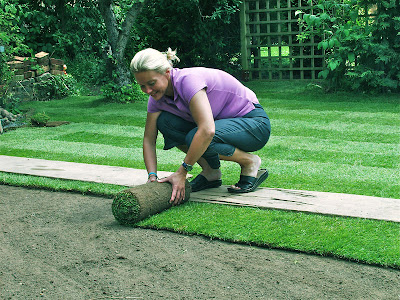Even before you consider laying a lawn, the ground will need to be suitably prepared so before you continue with this article, I will refer you to the following article:
HOW TO PREPARE GROUND FOR TURFING
Before you begin, you will need to mark out the area you want to turfed. Use a garden line for straight edges, and a length of hose or a suitable spray marker paint for curves and circles. Alternatively you can mark your edges by scratching out a shallow drill with a sturdy stick and fill this boundary line with sand.
A typical turf will be approximately 1ft x 3ft, but they can be found in larger sections.
They will be rolled up when they are delivered to you - hopefully not too wet - so make sure you have a sturdy pair of gloves available to move them to your desired location.
Depending on the amount of turf purchased, a decent wheel barrow at this point can be a god send!
You should lay your turf as soon as possible after delivery as turf can deteriorate quickly - especially in hot weather.
When should you lay turf?
The best time of year to lay turf is October to November, but turfing can continue up until February provided that the soil is neither frozen or waterlogged. You can turf in March or April, but this will mean regular watering when the weather is dry - be aware of hose pipe bans.
Turfing technique
1. Start with a single row along the side of the prepared lawn base which is either your longest stretch or the row nearest to your stack of turves.
If you can, use a long straight plank as an edging guide. Inspect each turf for before placing into position removing any 'rosette' weeds. If the turf is full of weeds then reject it.
2. When laying each turf, make sure the turf tools are closely butted together. gently push the turf into a joint - being careful not to stretch or compress it, and try to avoid having any gaps. Gently press the turf down into the soil but do not beat them down.
3. Check the level of the turf with a boards and spirit level after tamping down. If there are any bumps or hollows never the beat the turf down with the back of a spade. You should lift the turf and add or remove soil as necessary.
4. The final piece of turf at the end of the row should be a full-size or half-size turf. Fill the gap behind with a piece cut to fit.NOTE: Never use a small piece of turf at the end of a run. It will shrink or shift position-get knocked or move for any number of other reasons and ruin the look of your freshly laid lawn.
For related articles click onto:
How to Control Weeds in the Lawn
How to get rid of Lawn Weeds
How to Get Rid of Moss in Lawns?
How to Grow Banana Trees from Seed
How to Grow a Lawn from Seed
How to Grow the Sago Palm from Seed
How to Grow Palm Trees from Seed
How to Improve Drainage in Lawns
How to Kill Moss in Lawns
How to Prepare Ground for Turfing
How to Prepare a Lawn for Seeding
How to Lay Turf
What Causes Moss in Lawns?
Images care of http://www.exeterturf.co.uk/index.php?page=Turf-Laying

